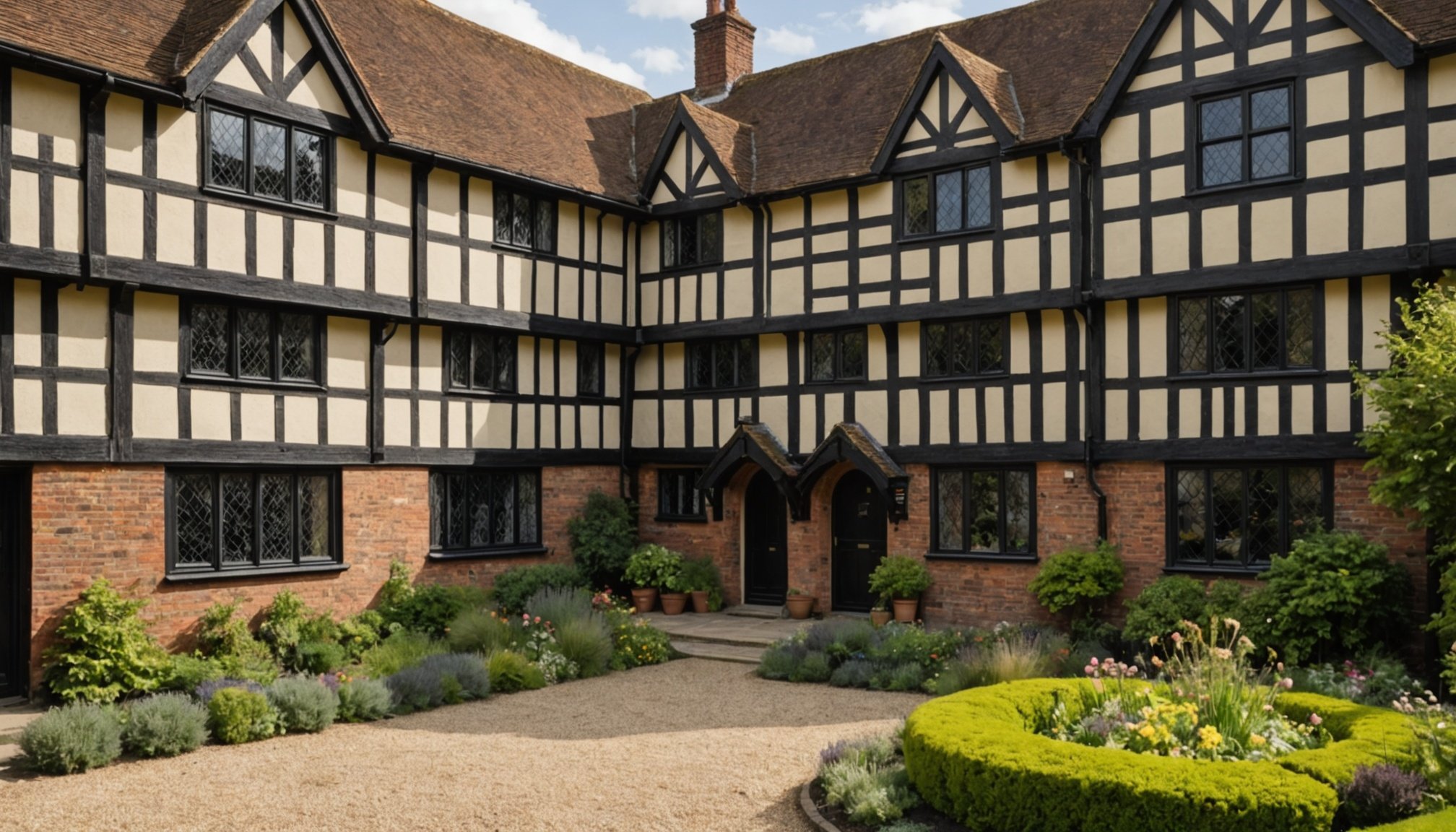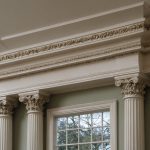Tudor architecture, with its charming timber frames and intricate detailing, offers a rich historical context that can enhance modern home decor. Merging this period's classic aesthetic with contemporary design principles creates unique and inviting spaces. Explore innovative ideas for incorporating Tudor elements into your home, from blending old-world charm with sleek furniture to using bold colors and textures that resonate with both eras. Transform your living space into a harmonious reflection of past and present, where every corner tells a story.
Understanding Tudor Architecture
Tudor architecture, a style that emerged in England during the late 15th century, is renowned for its distinctive historical features that have captivated enthusiasts for centuries. This architectural style is characterised by its steeply pitched gable roofs, elaborate chimneys, and half-timbered exteriors. These elements not only define its aesthetic appeal but also reflect the historical significance of the Tudor period.
A lire aussi : Top Herbs Perfect for Cultivating on Your UK Kitchen Windowsill
The evolution of Tudor architecture can be traced back to the transition from medieval Gothic styles to the Renaissance influences that swept across Europe. This blend resulted in a unique architectural style that combined traditional English craftsmanship with new ideas. The use of large, mullioned windows and intricate brickwork are examples of this fusion, showcasing both form and function.
Key features that define Tudor homes include the use of locally sourced materials, such as timber and brick, which contribute to their rustic charm. Interiors often feature exposed wooden beams and intricate stone fireplaces, adding to the overall historical ambiance. The asymmetrical layouts and ornamental detailing further distinguish Tudor architecture from other styles, making it a beloved choice for those seeking a connection to England's rich architectural heritage.
A voir aussi : Top Hypoallergenic Fabrics for a Healthier Bedroom: The Ultimate Guide for UK Homes
Creative Ways to Incorporate Tudor Elements
Incorporating Tudor-inspired design elements into modern homes can create a captivating blend of historical charm and contemporary style. By thoughtfully integrating these features, homeowners can enjoy the best of both worlds. One popular technique is to use half-timbering as an accent, offering a nod to traditional Tudor aesthetics while maintaining a sleek, modern look. This can be achieved through decorative panels or wallpaper that mimic the iconic timber framework.
Another approach is to incorporate steeply pitched gable roofs into new builds, providing a dramatic silhouette that pays homage to Tudor architecture. Pairing these roofs with large, modern windows can create a striking contrast, allowing natural light to flood the interior spaces.
For interiors, consider using exposed wooden beams to add warmth and texture, seamlessly blending with contemporary decor. These beams can be left in their natural state or painted in neutral tones to complement a minimalist aesthetic.
Successful case studies of Tudor-modern hybrid homes often showcase a careful balance of design integration. For instance, incorporating ornamental detailing on fireplaces or staircases can enhance the historical ambiance without overwhelming the contemporary elements. This thoughtful approach ensures that the blending of styles is both harmonious and visually appealing.
Practical Tips for Incorporation
Incorporating Tudor elements into your home requires thoughtful design advice to achieve a harmonious balance between modern and historical aesthetics. The first step is to select the right Tudor features that complement your existing space. Consider interior styling elements like exposed wooden beams or decorative half-timbering, which can be integrated without overwhelming the room.
When balancing aesthetics, it's crucial to maintain a seamless blend of styles. Home decor tips suggest using a mix of traditional and contemporary furnishings. For instance, pairing a Tudor-style fireplace with sleek, modern furniture can create an inviting focal point that respects both eras.
Color palettes play a significant role in this integration. Opt for neutral tones that highlight the natural beauty of materials like timber and brick. These colors can be accented with deeper hues, such as burgundy or forest green, to echo the period's richness.
Selecting materials that reflect Tudor craftsmanship is essential. Incorporate stone or brickwork for authenticity, while modern materials like glass or steel can add a contemporary twist. By carefully considering these elements, you can create a space that celebrates Tudor history while embracing modern design sensibilities.
Visual Inspirations
When seeking design inspiration for incorporating Tudor elements into modern decor, curated images can be invaluable. These decor photos offer a visual guide to blending historical charm with contemporary aesthetics. By examining these images, homeowners can better understand how to integrate Tudor features like half-timbering, steep gable roofs, and exposed beams into their spaces.
Visual examples often include diagrams illustrating effective design integration techniques. These diagrams can demonstrate how to balance traditional and modern elements, such as pairing ornate Tudor fireplaces with sleek, minimalist furniture. By providing a clear blueprint, these visuals aid in achieving a harmonious aesthetic.
Mood boards serve as another powerful tool, offering a collection of design inspiration that showcases the potential of blending styles. These boards might combine images of rustic brickwork with contemporary glass accents, highlighting the versatility of Tudor elements in a modern context. By exploring these curated visuals, homeowners can confidently embark on their design journey, ensuring their space reflects both historical elegance and modern sophistication.
DIY Projects to Enhance Your Space
Engaging in DIY decor projects can transform your home by infusing it with Tudor-inspired charm. These projects are not only budget-friendly but also allow for a personal touch in your home improvement journey.
Begin by exploring step-by-step guides for creating Tudor-inspired decor items. For example, crafting a half-timbered wall panel can be achieved with a few simple tools and materials. You'll need timber strips, wood stain, and adhesive. Measure and cut the timber to fit your wall space, stain the wood to achieve a rustic finish, and adhere the strips in a crisscross pattern to mimic traditional Tudor designs.
For those interested in creative projects on a budget, consider making decorative stone fireplace surrounds. Using faux stone panels and basic construction adhesive, you can create a stunning focal point without the expense of real stone.
Essential tools for these projects include a saw, measuring tape, and a paintbrush. Materials like timber, faux stone panels, and wood stain are readily available at most home improvement stores. With a little creativity and effort, you can successfully integrate Tudor elements into your home.
Product Recommendations
Incorporating Tudor style into your home decor can be effortlessly achieved with the right furniture suggestions and accessories. Selecting pieces that echo the grandeur of the Tudor period adds a touch of historical elegance to any space.
When considering home decor products, look for furniture with rich woods and intricate carvings. A solid oak dining table with turned legs or a high-backed chair with upholstered seats can serve as a centerpiece, reflecting the opulence of Tudor design. For smaller spaces, a carved wooden chest can add both storage and style.
To find Tudor-inspired decor items, explore antique shops or specialised retailers that focus on historical reproductions. These sources often carry authentic-looking items such as wrought iron candle holders or tapestry wall hangings, which can enhance the historical ambiance of your home.
For those seeking authentic Tudor-style accessories, online marketplaces and auctions can be a treasure trove. Look for items like vintage pewter dishes or stained glass panels, which can infuse your home with period charm. By carefully selecting these pieces, you can create a cohesive and inviting space that pays homage to the Tudor era.
Maintaining Character in Contemporary Settings
Maintaining the historical accuracy of Tudor architecture while updating a home can be a rewarding challenge. To preserve the architectural integrity of Tudor elements, it is crucial to approach renovations with a focus on home preservation. This means prioritizing original features like exposed beams, stone fireplaces, and half-timbering.
When embarking on renovations, consider the following tips to maintain architectural integrity:
-
Respect Original Materials: Use reclaimed timber or brick that matches the original construction. This ensures that any new additions blend seamlessly with the existing structure.
-
Consult Experts: Engage with architects or designers who specialize in historical renovations. Their expertise can guide you in making informed decisions that respect the home's heritage.
-
Balance Modern and Historical: While modern amenities are essential, they should be integrated in a way that complements the Tudor style. For example, choosing minimalist fixtures that do not detract from the historical charm.
Balancing modernization with historical authenticity requires thoughtful planning and a commitment to preserving the unique character of Tudor architecture. By following these guidelines, homeowners can enjoy contemporary comforts without compromising on the historical essence of their homes.
Expert Insights and Perspectives
Exploring the world of Tudor architecture through expert opinions offers invaluable interior design tips and architectural advice. Interviews with interior designers who specialise in Tudor styles reveal a growing trend of blending historical elements with modern aesthetics. These professionals emphasise the importance of maintaining the historical integrity of Tudor features while integrating contemporary comforts.
Interior designers suggest focusing on key elements like exposed beams and stone fireplaces, which can serve as focal points in a modern setting. Their advice often includes using neutral colour palettes to highlight these features, ensuring they stand out without overwhelming the space. Additionally, they recommend incorporating modern materials subtly, such as glass or steel, to enhance the overall design.
Historians provide insights into preserving Tudor elements, stressing the significance of using authentic materials. They advocate for sourcing reclaimed timber and bricks to match original constructions, ensuring any renovations respect the home's heritage. Their architectural advice includes consulting with specialists to guide restoration projects, balancing modernity with historical accuracy.
By following these expert perspectives, homeowners can achieve a harmonious blend of Tudor charm and contemporary style, creating spaces that are both timeless and inviting.
Resources for Further Exploration
For those eager to delve deeper into the world of Tudor architecture, a wealth of additional resources awaits. Enthusiasts can begin their journey with books dedicated to this historical style. Titles such as "Tudor Style: Tudor Revival Houses in America from 1890 to 1930" offer detailed insights into the architectural nuances and evolution of Tudor design. Additionally, "The Tudor Home" provides a comprehensive look at the historical context and key features that define this iconic style.
Online platforms also serve as valuable resources for further exploration. Websites like Architectural Digest and Houzz feature articles and galleries that showcase Tudor architecture, offering further reading for those interested in design inspiration. These platforms often include interviews with architects and designers, providing professional insights into blending Tudor elements with modern aesthetics.
For interactive engagement, online forums and communities such as Reddit's design threads or specialized Facebook groups are excellent venues for connecting with fellow design enthusiasts. These communities allow for the exchange of ideas, tips, and experiences related to Tudor restoration and decor.
Locally, architectural tours and historical societies can provide tangible inspiration and knowledge, highlighting the enduring charm of Tudor architecture.











